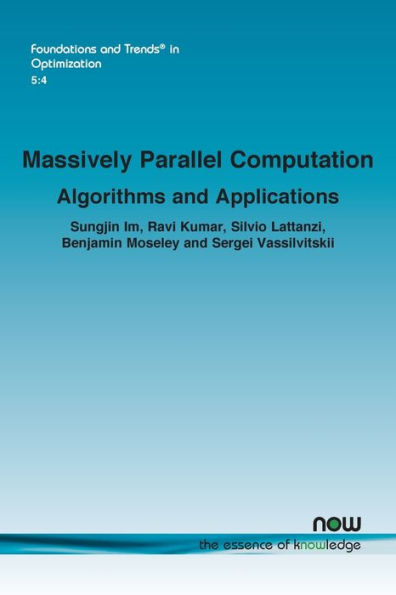Massively Parallel Computation: Algorithms and Applications
The modern era is witnessing a revolution in the ability to scale computations to massively large data sets. A key breakthrough in scalability was the introduction of fast and easy-to-use distributed programming models such as the Massively Parallel Model of Computation (MPC) framework (also known as MapReduce). The framework describes algorithmic tools that have been developed to leverage the unique features of the MPC framework. These tools were chosen for their broad applicability, as they can serve as building blocks to design new algorithms.
In this monograph the authors describe in detail certain tools available in the framework that are generally applicable and can be used as building blocks to design algorithms in the area. These include Partitioning and Coresets, sample and prune, dynamic programming, round compression, and lower bounds.
This monograph provides the reader with an accessible introduction to the most important tools of a framework used for the design of new algorithms deployed in systems using massively parallel computation.
1144134324
In this monograph the authors describe in detail certain tools available in the framework that are generally applicable and can be used as building blocks to design algorithms in the area. These include Partitioning and Coresets, sample and prune, dynamic programming, round compression, and lower bounds.
This monograph provides the reader with an accessible introduction to the most important tools of a framework used for the design of new algorithms deployed in systems using massively parallel computation.
Massively Parallel Computation: Algorithms and Applications
The modern era is witnessing a revolution in the ability to scale computations to massively large data sets. A key breakthrough in scalability was the introduction of fast and easy-to-use distributed programming models such as the Massively Parallel Model of Computation (MPC) framework (also known as MapReduce). The framework describes algorithmic tools that have been developed to leverage the unique features of the MPC framework. These tools were chosen for their broad applicability, as they can serve as building blocks to design new algorithms.
In this monograph the authors describe in detail certain tools available in the framework that are generally applicable and can be used as building blocks to design algorithms in the area. These include Partitioning and Coresets, sample and prune, dynamic programming, round compression, and lower bounds.
This monograph provides the reader with an accessible introduction to the most important tools of a framework used for the design of new algorithms deployed in systems using massively parallel computation.
In this monograph the authors describe in detail certain tools available in the framework that are generally applicable and can be used as building blocks to design algorithms in the area. These include Partitioning and Coresets, sample and prune, dynamic programming, round compression, and lower bounds.
This monograph provides the reader with an accessible introduction to the most important tools of a framework used for the design of new algorithms deployed in systems using massively parallel computation.
70.0
In Stock
5
1

Massively Parallel Computation: Algorithms and Applications
92
Massively Parallel Computation: Algorithms and Applications
92Paperback
$70.00
70.0
In Stock

Product Details
| ISBN-13: | 9781638282167 |
|---|---|
| Publisher: | Now Publishers |
| Publication date: | 09/28/2023 |
| Series: | Foundations and Trends in Optimization , #15 |
| Pages: | 92 |
| Product dimensions: | 6.14(w) x 9.21(h) x 0.19(d) |
From the B&N Reads Blog
